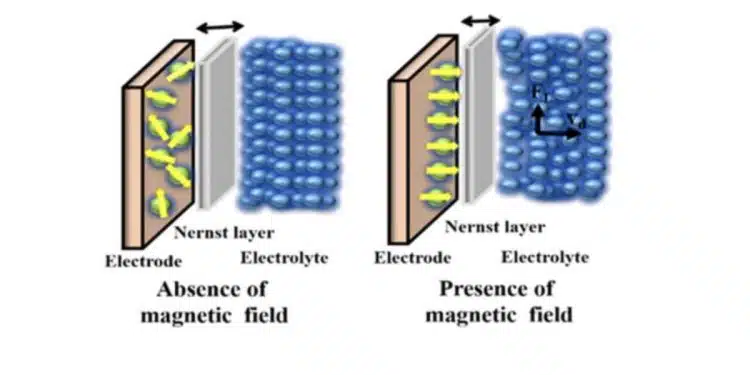Researchers from McMaster University, Ontario, Canada investigated pseudocapacitive (PC) materials for energy storage in supercapacitors, that exhibits magnetic supercapacitor features in a single material.
The ability to combine high electrical capacitance with advanced ferrimagnetic or ferromagnetic properties in a single material at room temperature opens an avenue for the development of advanced magnetically ordered pseudocapacitive (MOPC) materials.
This review covers materials science aspects, charge storage mechanisms, magnetocapacitance, and magnetoelectric (ME) phenomena in MOPC materials.
Recent studies demonstrate high PC properties of advanced ferrimagnetic materials, such as spinel ferrites and hexagonal ferrites. Of particular importance is the discovery of PC properties of perovskite-type manganites, which exhibit room temperature ferromagnetism and giant negative magnetoresistance.
The coupling of high capacitance and magnetization in MOPC provides a platform for strong ME interactions. Various strategies are used for manipulation of electrical capacitance/magnetization of MOPC by a magnetic field/electrode potential.
Magnetocapacitance studies show significant increase in capacitance of MOPC under the influence of a magnetic field. Moreover, the application of a magnetic field results in enhanced energy density and power density, reduction of resistance, and improvement of cyclic stability. Such findings offer a potential of a breakthrough in the development of advanced supercapacitors.
High magnetocapacitance and ME phenomena are linked to the influence of magnetic fields on electrolyte diffusion, structure of electrical double layer, charge transfer resistance, and variation of conductivity and magnetization of MOPC materials, which facilitate charge/discharge behavior. Various applications of ME effect in MOPC are discussed. Moreover, advantages of magnetocapacitive MOPC are described for applications in electronic and spintronic devices, supercapacitors, and devices for magnetically enhanced capacitive deionization of water.
The ability to control magnetic/electric properties of materials in electric/magnetic fields opens an avenue for the fabrication of novel multifunctional devices. Various phenomena were described in the literature, which are based on the direct or indirect effect of electric field on magnetization. The interdependence between magnetization and electric charge transport provides a platform for various applications based on anisotropic and giant magnetoresistance (GMR).
Crystal structure of materials and their composition are important factors governing ferroelectric and magnetic ordering in metal oxide materials. Many advanced ferroelectric materials, such as BaTiO3, PbTiO3, and Pb(ZrxTi1−x)O3 belong to perovskite family with a general formula of ABO3. It is known that highly polarizable ions such as Pb2+ and Bi3+ with lone pair electrons in A position of the perovskite lattice and Ti4+ and Nb5+ ions in B position favor the formation of ferroelectric polarization.
A new research avenue in magnetic capacitive materials and ME interactions resulted from the discovery of unique pseudocapacitive properties of advanced spinel ferrimagnetic materials, such as Fe3O4, CuFe2O4, and NiFe2O4. The combination of high capacitive properties and high magnetization at room temperature is promising for the development of conceptually new magnetically ordered pseudocapacitor (MOPC) devices based on ME coupling. The development of such devices can potentially overcome limitations of multiferroics for various applications and result in novel applications in multifunctional devices.
The analysis of charge storage mechanisms and materials science aspects of MOPC reveals their unique features. The electric charge storage properties of MOPC are related to redox reactions of paramagnetic metal ions. The electrochemical reduction or oxidation of such ions results in changing of their magnetic moments, which influence their exchange or superexchange magnetic interactions. Therefore, electrochemical reactions can result in decrease or increase in magnetization. This provides a platform for a strong ME coupling.
This review covers materials science aspects and fundamental properties of MOPC. It is focused on recent developments in advanced MOPC metal oxides, which exhibit ferri- or ferromagnetic properties at room temperature and high electrical capacitance.
CONCLUSIONS AND FUTURE OUTLOOK
Innovative studies during recent years have led to the development of MOPC materials, which combined advanced PC properties with ferrimagnetism or ferromagnetism at room temperature. Advanced ferrimagnetic materials, such as spinels and hexagonal ferrites, and ferromagnetic manganites exhibited high pseudocapacitance. Magnetic and capacitive properties of MOPC are superior to other materials, such as multiferroics.
The advanced capacitive and magnetic properties of MOPC provide a platform for interesting ME interactions, which are promising for applications in various energy storage devices, sensors, water purification systems, and electronic devices. Strong ME coupling and unprecedented reversibility in MOPC open an avenue for novel applications in spin polarized supercapacitor devices, magnetic memories, magnetoelectric actuators, transducers, and bioelectronic devices.
Many examples throughout the literature showed that application of magnetic field to MOPC results in significant increase in capacitance, reduced resistance, increased capacitance retention at high charge–discharge rates, improved cyclic stability, and enhanced power-energy characteristics. Therefore, the use of magnetic field offers a potential of technological breakthrough in the development of advanced supercapacitors with enhanced performance for energy storage devices, capacitive water purification systems, and electronic devices.
It is expected that progress in materials science of MOPC will result in the discovery of new ME phenomena and development of novel devices for applications in energy storage, electronic industry, spintronics, and sensors. Supercapacitors have generated significant interest for industrial devices for capacitive deionization (CDI) of water. The use of magnetic field for MOPC-based CDI devices is promising for the development of advanced water purification systems. The ME coupling can be combined with optical, photovoltaic, mechanical, and other properties and offers an opportunity for the fabrication of novel multifunctional devices. The origin of ME interactions in MOPC is still not well understood. New fundamental investigations in the MOPC charging mechanism and ME interactions are critically important for further development of this area.
Read the full paper:
Rebecca Sikkema, Igor Zhitomirsky; Magnetic supercapacitors: Charge storage mechanisms, magnetocapacitance, and magnetoelectric phenomena. Applied Physics Reviews 1 June 2023; 10 (2): 021307. https://doi.org/10.1063/5.0134593































